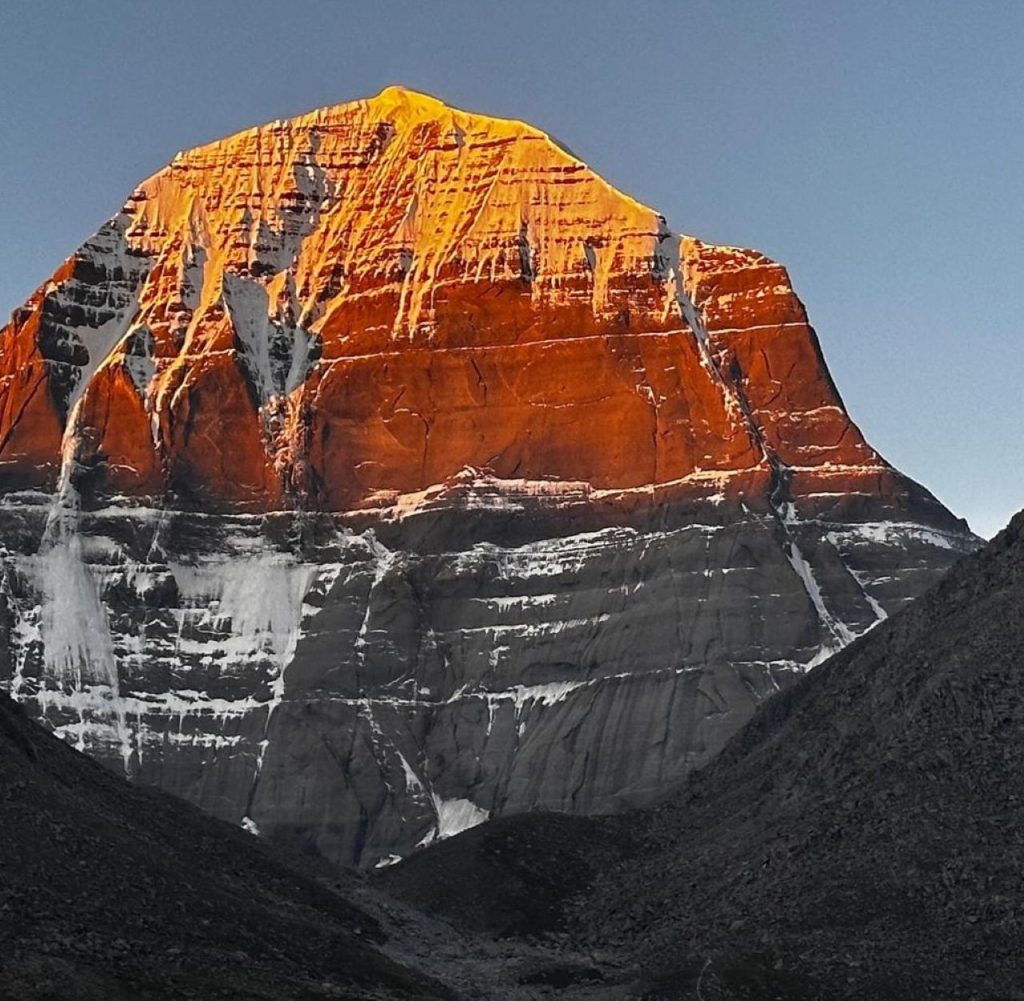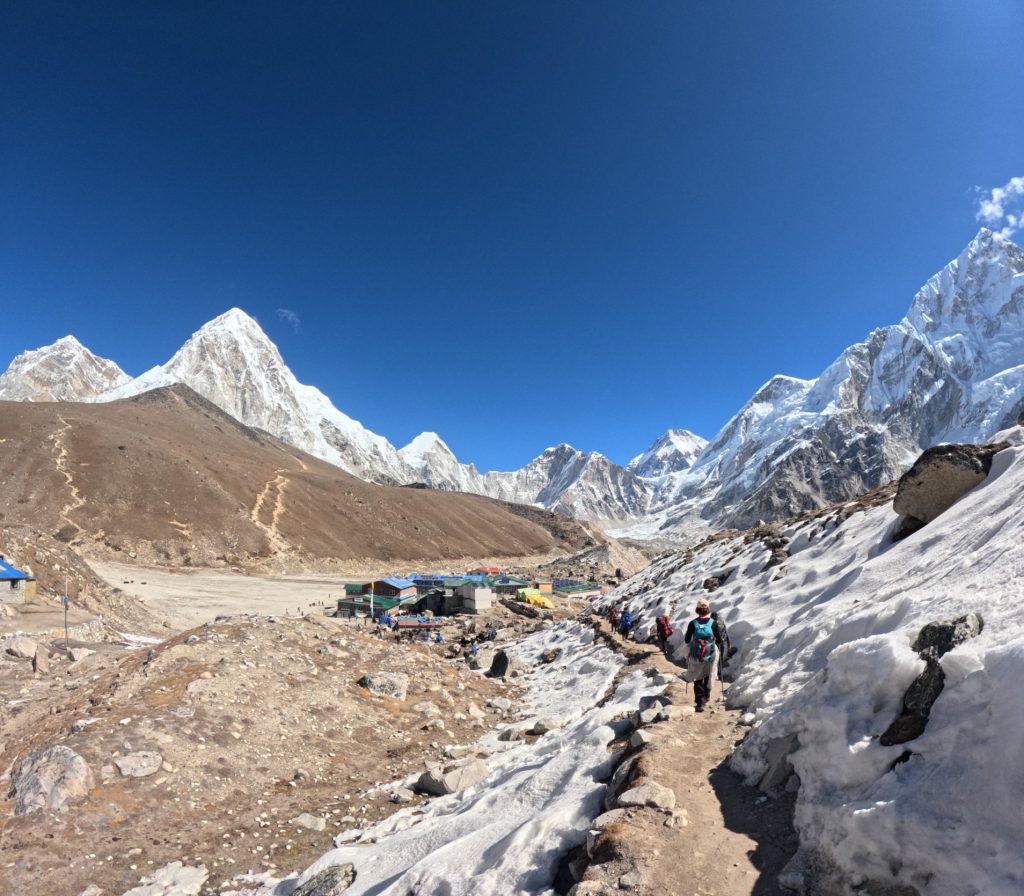Island Peak(6,189m) has a picturesque location. The mountain peak of Island Peak provides breathtaking scenery comprising the highest mountains in the world, such as Lhotse, Nuptse, and others. The journey to its summit is not only a test of one’s physical stamina but also an opportunity to experience Sherpa culture as mountaineers pass through some of the beautiful villages and monasteries along the way.
The feeling of satisfaction and wonder will overcome you as you conquer the highest point of Island Peak. When you are at the top of this magnificent mountain and see the infinity of the Himalayas, you will have a great respect for how powerful nature is and how resilient people can be.
Climbing on Island Peak requires some technical skills that are moderate in intensity, including basic mountaineering techniques and the use of climbing equipment. However, under guidance from experienced Sherpas and professional climbing teams, even beginners can engage in this amazing adventure.
Therefore, if you want a blend of stunning landscapes, cultural immersions, historical riches, and an exciting climbing experience, then the island peak in the spring/autumn seasons should be your destination. Prepare yourself for a once-in-a-lifetime journey that no one would ever wish to forget.
Let’s dive in season-wise so that you can choose the best time to climb Island Peak
Table of Contents
Autumn Season(September, October, November)
Autumn in the Himalayas usually occurs between September through November, which is a time when monsoon rains have gone, and it’s sunny with no clouds. The days are warm, and visibility is excellent, while the nights are cool, perfect for stargazing. The temperatures at this time of the year are also relatively mild and thus comfortable enough to make climbers navigate through challenging terrains.
The cooler fall temperatures in autumn help climbers acclimatize to high altitudes more easily, thereby reducing the risk of altitude sickness. Moreover, mountain routes are usually well-defined and free from snow accumulation, making navigation easier and reducing technical difficulties involved in climbing Island Peak.
Benefits of climbing Island Peak in the Autumn season
- Clear skies and stable conditions make for safer and more enjoyable climbing.
- The surrounding landscapes are adorned in vibrant autumn colors, providing breathtaking views.
- Autumn months offer a sense of solitude and tranquility.
- The combination of milder temperatures and stable weather makes it an ideal time to tackle the challenge of Island Peak.
Spring Season(March, April, May)
Island Peak climbing during spring is the best time because of its stable weather conditions, which enables climbers to have clear visibility and safer climbing routes. The days are pleasantly warm, while nights are cool, allowing for comfortable rest and recovery. The route itself presents a mix of challenging sections, including steep ascents, icy slopes, and rocky terrain, thereby making it an exciting and rewarding adventure for those seeking an adrenaline rush.
One of the highlights of climbing Island Peak in the spring is the vibrant display of rhododendron flowers. These magnificent blooms paint the mountainside red, pink, or white, making a breathtaking backdrop as you make your way towards the summit. You will be amazed by this natural beauty, and it will provide ample opportunities for memorable photographs.
Benefits of climbing Island Peak in the Spring season
- Spring brings milder temperatures, creating more comfortable climbing conditions.
- The surrounding areas come alive with blooming flora, creating a picturesque setting for climbers.
- Spring offers longer daylight hours, providing more time for climbing and taking in the scenery.
- While spring can be a popular time for climbing, it typically offers a good balance of manageable crowds and favorable weather.
Winter Season(December, January, February)
Winter is one of the best seasons to climb Island Peak as it offers challenging but rewarding experiences. In the Everest region, for instance, the winter season spans from December to February. During such periods, weather conditions can be very severe, with extremely low temperatures, heavy snowfall, and strong winds blowing on some occasions. Nonetheless, those who prefer a less crowded climbing experience will find nothing better than winter climbing on Island Peak.
One of the main challenges of climbing Island Peak in winter is the cold. Temperatures drop below freezing point, especially at higher altitudes. Climbers must be well-prepared with appropriate clothing like insulated clothing, down jackets, thick gloves, and sturdy boots. Additionally, it is also necessary to have proper equipment for snow and ice travel, such as crampons and ice axes, as the route may be covered in snow and ice.
Benefits of climbing Island Peak in the Winter season
- The chances of rainfall are very low and easy to access flight tickets.
- The mountain is less crowded, with fewer climbers on the trail.
- The views are often better, with clearer skies and less haze.
- The cost of climbing is lower, as there are fewer people competing for permits.
However, there are also some risks associated with climbing Island Peak in the winter, including:
- The cold weather can make it more difficult to acclimatize to the altitude.
- The snow and ice can make the climbing more challenging.
- There is a higher risk of avalanches and other hazards.
Overall, climbing Island Peak in the winter can be a rewarding experience, but it is important to be aware of the risks involved and to be prepared for them.
Monsoon season(June, July, August)
The monsoon season, also known as the summer season, occurs between June and August. During this season, it receives the maximum rainfall than any other season. Due to the hot climatic conditions and sudden changes in the weather, it is unpredictable for climbers to predict weather.
Therefore, we do not recommend you climb during this season. If you like, the best time to climb in monsoon is early June, as the chances of rainfall are lower than in July and August. Climbers need to pack their clothing waterproof to prevent them from getting wet. Also, the leeches and mosquitoes are highly active in this season, so prepare well if you head during this season.
Benefits of climbing Island Peak in the Monsoon season
- When the weather is clear, you can better view the mountains and the surrounding area. This is because the clouds are lower, and the air has less haze.
- Fewer people climb Isle Peak during the monsoon season. This means that you will have more space to yourself and you won’t have to wait in line as much.
- The cost of climbing Isle Peak is lower during the monsoon season. This is because fewer people are climbing, and the companies that run the trips can charge less.
However, there are also some risks associated with climbing Island Peak in the monsoon, including:
- The monsoon season is a more challenging time to climb Island Peak. This is because the weather is more unpredictable and there is more rain. However, this can also make it more exciting and rewarding if you are able to complete the climb.
- The monsoon rains make the trails slippery and difficult to navigate.
- The heavy rains can cause landslides and rockfalls, which can be dangerous for climbers.
- The weather can be unpredictable, with sudden storms and strong winds.
Combine Island Peak with Everest Base Camp
After determining the best time, let’s see why you should combine Island Peak Climbing with Everest Base Camp. One of the main reasons is adequate acclimatization before embarking toward the Island Peak Summit at 6165 meters. It helps you to adapt your body to the high altitude and provides enough time to prepare for the summit.
Spending time in the Everest region means you will be in for an unforgettable adventure. So don’t let this once-in-a-lifetime opportunity slip away! Make sure to visit these iconic landmarks like Everest Base Camp and the Kala Patthar. Picture yourself standing amidst the majestic mountains, with the mighty Mt. Everest glistening in the golden rays of sunshine. It’s like a scene straight out of a dream, one you will cherish forever.
So why wait? Seize the moment, embrace the adventure, and make memories that will last a lifetime in the Everest region.
Climbing Gear and Equipment for Island Peak Climbing
Whichever season you choose for the Island Peak Climbing it is essential to have proper Gear and Equipment. Make sure to choose the best product and check the equipment well so that it does not ruin your journey. This gear and equipment are like your friend which will help you to tackle challenges that will arise during the climbing journey.
Climbing Equipment
- Ice Axe
- Crampons
- Climbing Helmet
- Climbing Harness
- Belay/Rappel Device
- Locking Carabiners
- Non-Locking Carabiners
- Mechanical Ascender
- Waist Leash
- Microspikes
Body Wear
- Waterproof Shell Jacket
- Waterproof Shell Trousers
- Expedition Down Jacket and Trousers
- Midweight Insulated Jacket
- Fleece Tops and Trousers
- Long Sleeve Sun Shirt
Foot Wear
- Snow Gaiters
- Three to five pairs of Woolen and Synthetic Socks
- Mountaineering Boots
- Trekking Boots
Head Wear
- Warm Hat
- Ski Goggles
Hand Wear
- Fleece Gloves
- Lightweight Liner Gloves
- Mountaineering Gloves
- Expedition Mittens
Camping Gear
- Down Sleeping Bags
- Foam and Inflatable Sleeping Mat
- Random Accessories
- Headlamps
- First Aid Kit
- Tool Kit
Final Say
The trip to Island Peak is not only a physical challenge but also gives you a chance to involve yourself in Sherpa culture. Here, you will meet hospitable local communities and monasteries, as well as prayer flags waving in the mountain breeze. This cultural experience brings more depth and meaning to your adventure, hence making it unforgettable.
Embarking on an Island Peak Climbing journey will push your limits and reward you with awe-inspiring views. Also, this beautiful journey will leave you with memories to cherish for a lifetime. So pack your climbing gear and equipment and set your sights on Island Peak. If you are ready to conquer or have questions about Island Peak Climbing, you can message or contact us.





